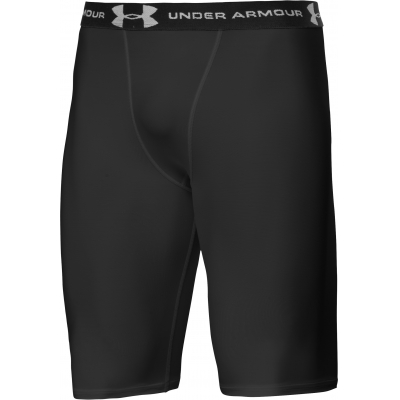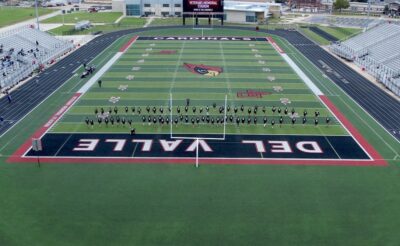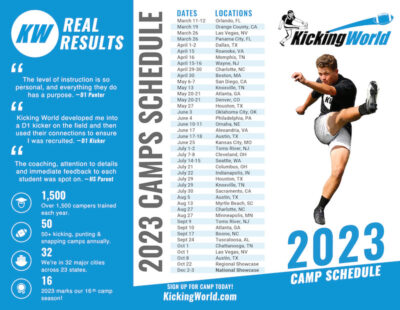The 5 Most Common Kicking Injuries: #3 Quadriceps
The 5 Most Common Kicking Injuries and How to Prevent, Recognize & Heal!
#3 Quadriceps
(derived from the Latin word for “four heads” of the femur)
Let me preface this series of articles by saying I am NOT a Doctor and the following information does not in any way constitute a recommendation or advice by me for your individual and specific situation. This article is for informational purposes only and is based solely on my experience as a former All-American collegiate kicker turned professional kicking coach with over 9 years of coaching experience. If you have an injury that persists and is not improving, you should speak with your trainer, visit a physical therapist and quite possibly even a doctor for further consultation, proper diagnosis and a recommended solution.
I hope the following information on the 5 most common kicking injuries helps you. As always feel free to drop me an e-mail or check out our website www.kickingworld.com and all our other sites like YouTube, Facebook and this Blog for everything football kicking and punting.
 #3 Quadriceps (Pull/Strain)
#3 Quadriceps (Pull/Strain)
The quadriceps consist of 4 major muscles in the front of the thighs:
* Rectus Femoris
* Vastus Lateralis
* Vastus Medialis
* Vastus Intermedius
Those muscles sound pretty ‘official’ huh? Well, they are Latin words meaning: Rectus (Straight), Vastus (Resister). All 4 components of the Quadriceps are extensors of the knee joint. The Rectus Femoris also helps in flexing of the hip.
How Can I hurt my Quadriceps?
Kickers and Punters can experience a quadriceps pull and strain quite easily when they ‘overload’ their leg. What I mean by that is, say you are a beginner kicker, maybe 13 or 14 years old and previously you played soccer. You never kicked a football before (it’s a completely different motion). You go out on your first day of kicking and use mostly your ‘quad’ muscle to kick the ball. That’s ok, but the problem is you kicked 50 footballs, and you never kicked a football a day in your life before that! Things like that put you at risk of pulling any muscle, especially something like the quadriceps. Another way you can hurt your quadriceps is by kicking too much weight or lifting too much weight with that muscle. An example would be your leg is not ‘kicking conditioned’ and you’ve never worked that muscle hard before. You go out and kick a 1+ pound football around all day and that heavy resistance takes a toll. After one wrong kick your leg just says – wow, this is too much to handle and shuts down. The Quadriceps could be the first thing to give out.
So I’m hurt, now what?
So what can you do if you hurt your Quadriceps? Well, it’s not too far off from the protocol discussed in the previous article on Hamstrings. Follow the procedure of Rest, No Kicking or Punting for a few days, Ice and Anti-Inflammatory. Another great idea is to ‘wrap’ your quad if you absolutely have to kick (i.e. if this happens during the season and you can’t just choose to sit out for a week). Or get kinesio tape and set yourself up (this stuff is good for several injuries). You can ask your athletic trainer at school to do this. That tight compression (not too far off from wearing a real tight Under Armour shirt when weight lifting) will help keep the muscles in place and cut down on everything moving around and causing more issues and more pain. It should in theory help to warm up the area and cut down on the discomfort enough to help get you through the game. Another good thing to try is gently massaging and stretching the injured area.
 Ouch, You Did What?!
Ouch, You Did What?!
Regardless if you are injured or not, I feel it is an absolute necessity for kickers and punters to wear some style of ‘compression shorts’ while they kick and punt. The following story may sound completely ‘nuts’, but it is a true story. I got a call from a student a couple years ago saying he couldn’t make our lesson that coming weekend (and he never cancels and was 100% committed to training) so something did not seem right. I asked him, ‘what’s up’? He hesitantly replied, “I was out kicking with my shorts and boxer shorts and twisted my balls”. (LOL) I kid you not. Of course, I am not referring to footballs. It took my student a couple months to recover from this injury after having had surgery to ‘un-twist’ them (OUCH!). The moral of the story is, make sure you wear some sort of compression short like an Under Armour or Nike. They don’t have to be so tight that they cut your circulation or anything like that, but just tight enough to keep everything secure and this will help you several ways:
- Keep your muscles warm
- Prevent ‘stuff’ from bouncing around
- Help prevent and calm injuries
Follow the above steps and they should absolutely help you on your road to recovery.
How Many Balls Should I Kick?
Remember to be diligent in all you do, keep a log of how many balls you kick each day and be wary of kicking more than you need. Typically I recommend a good practice session should include 40-45 total balls kicked. So if you are a field goal kicker who also does kickoffs, that could mean maybe 30-35 field goals and 7-10 kickoffs. If you punt also, just mix it in and switch it up each day based on what your priorities are.
Stay tuned for the #2 Most Common Kicking Injury and how to prevent, recognize & heal it!
RESOURCES
Complete Guide to Kicking (DVD)
Complete Guide to Kicking & Punting (Book)
Step by Step Guide to Punting (DVD)
Next Steps
Signup for Camps, Private Lessons, and Purchase my Instructional DVD & Book at KickingWorld.com
Coach Brent Grablachoff is a Professional Kicking Coach and the Owner of Kicking World. He trains Professional, Collegiate, HS & MS, and Youth football kickers and punters. He and his staff travel to over 50 camps across 22 states and also offer year-round private instruction. Coach Brent is based out of Austin, Texas.



 About the Author
About the Author



